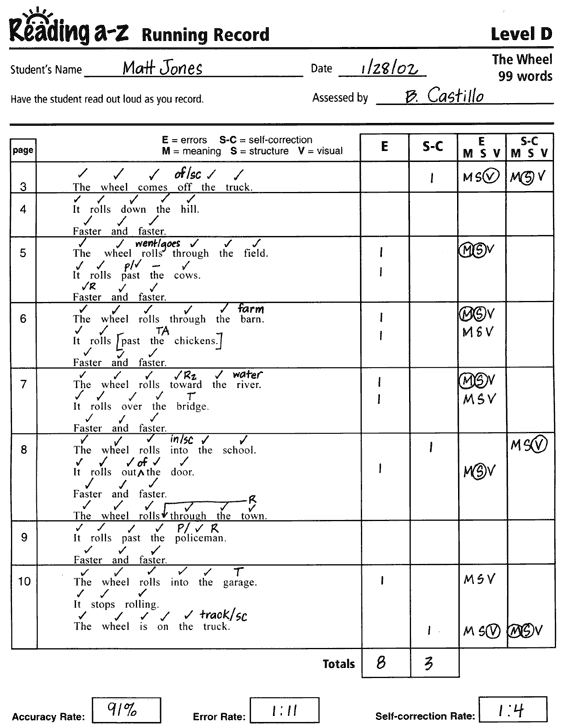Back
|
Back |
|
A running record is a record a teacher makes while a student is reading aloud. A variety of ways can be used to record information such as recording a tick for each word read correctly, recording a dash when a word is omitted, etc. |
![]() N.B Running Records used by "reading
recovery teachers" and developed by Dame Marie Clay
N.B Running Records used by "reading
recovery teachers" and developed by Dame Marie Clay
follow
strict guidelines with respect to administration and scoring, and differ
in some ways from the sample represented below.
|
Does the child have mastery of directionality, one-to-one correspondence, return sweep, etc.? Did the errors made by the child make sense or sound right? Did the child attempt to self-correct? Did the child use the meaning, structure, and visual cues to identify words and get meaning from the text? Did he or she use them in an integrated way, or did he or she rely heavily on one particular source of information? Did the child make an attempt to read a word before asking you to help? How was the child’s fluency? Did she or he just word-call? Did the child seem to recognize phrases? Were there many pauses? Were the pauses lengthy? How was the child’s expression or intonation? |

|
Self-correction occurs when a child realizes his or her error and corrects it. When a child makes a self-correction, the previous substitution is not scored as an error. Meaning (M) Meaning is part of the cueing system in which the child takes his or her cue to make sense of text by thinking about the story background, information from pictures, or the meaning of a sentence. These cues assist in the reading of a word or phrase. Structure (S) Structure refers to the structure of language and is often referred to as syntax. Implicit knowledge of structure helps the reader know if what he or she reads sounds correct. Visual (V) Visual information is related to the look of the letter in a word and the word itself. A reader uses visual information when he or she studies the beginning sound, word length, familiar word chunks, etc. |
|
Does the child include details about the characters in the retelling? Can the child describe the setting? How much detail is evident ? Can the child recall the events of the story, placing them in the correct sequence? Does the child use vocabulary from the text? Does the child’s retelling demonstrate minimal, adequate, or very complete and detailed understanding of the text?
|
Reading A-Z
1630 E. River Road Suite #121
Tucson, AZ 85718-5834
Phone: (520) 327-3730 Fax:
(520) 327-9934
http://www.readinga-z.com/index.php
